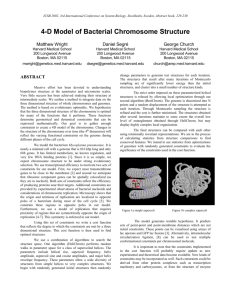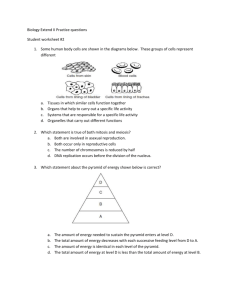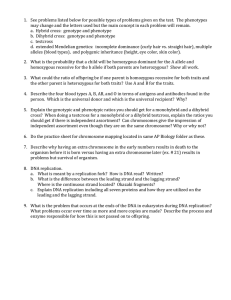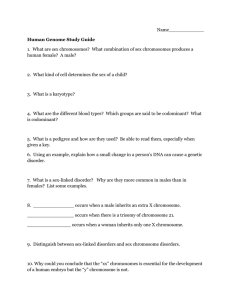Cell cycle: The bacterial approach to coordination Please share
advertisement
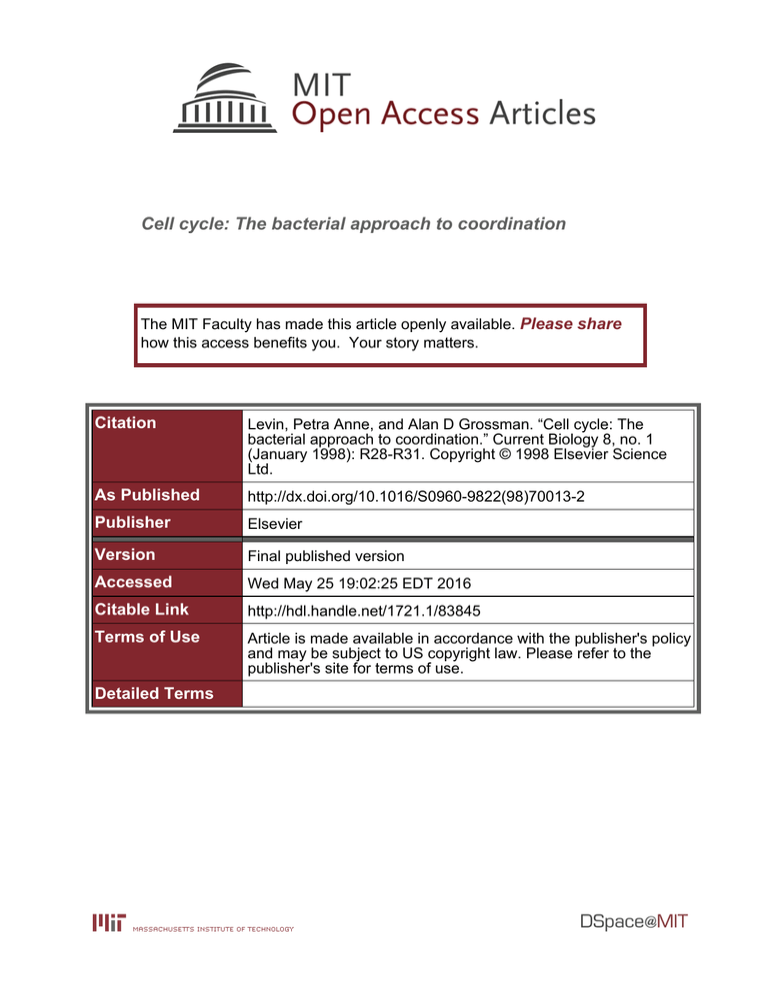
Cell cycle: The bacterial approach to coordination The MIT Faculty has made this article openly available. Please share how this access benefits you. Your story matters. Citation Levin, Petra Anne, and Alan D Grossman. “Cell cycle: The bacterial approach to coordination.” Current Biology 8, no. 1 (January 1998): R28-R31. Copyright © 1998 Elsevier Science Ltd. As Published http://dx.doi.org/10.1016/S0960-9822(98)70013-2 Publisher Elsevier Version Final published version Accessed Wed May 25 19:02:25 EDT 2016 Citable Link http://hdl.handle.net/1721.1/83845 Terms of Use Article is made available in accordance with the publisher's policy and may be subject to US copyright law. Please refer to the publisher's site for terms of use. Detailed Terms R28 Dispatch Cell cycle: The bacterial approach to coordination Petra Anne Levin and Alan D. Grossman Despite the power of bacterial genetics, the prokaryotic cell cycle has remained poorly understood. But recent work with three different bacterial species has shed light on how chromosomes and plasmids are oriented and partitioned during the cell cycle, and on mechanisms regulating the initiation of DNA replication. Address: Department of Biology, Building 68–530, Massachusetts Institute of Technology, Cambridge, Massachusetts 02139, USA. E-mail: adg@mit.edu Current Biology 1998, 8:R28–R31 http://biomednet.com/elecref/09609822008R0028 © Current Biology Ltd ISSN 0960-9822 Until recently it was thought that bacteria lacked much of the subcellular organization observed in eukaryotes. Descriptions of bacteria often made them out to be sacks of enzymes in which the major cytological features were the cell membrane (or cell wall) and the amorphous, bloblike nucleoid containing the bacterial genome. But now techniques developed for use in eukaryotes are being applied to prokaryotic cells and are revealing a level of subcellular organization akin to that of their eukaryotic counterparts. The use of immunofluorescence microscopy and fusion proteins involving the green fluorescent protein (GFP) has been particularly enlightening in the study of the bacterial cell cycle. Both the prokaryotic and eukaryotic cell cycles include periods of DNA synthesis, chromosome partitioning (mitosis) and cytokinesis. The presence or absence of defined gaps between these stages often depends on cell type and growth rate. Our understanding of the mechanisms controlling the bacterial cell cycle has lagged behind that of the eukaryotic cell cycle. In part, this was because of the lack of cell biological approaches in work with bacteria. Furthermore, rapid growth conditions, often used for the genetically tractable prokaryotes, complicate analysis of the cell cycle. Under conditions of rapid growth, the time needed to replicate the entire bacterial genome is longer than the cell division time. Some bacteria avoid this problem by never growing fast, others by having multiple and overlapping rounds of replication per division cycle. During rapid growth, the steps in the bacterial cell cycle all overlap. That is, replication, chromosome partitioning, and cell division all happen simultaneously. It is convenient to examine the bacterial cell cycle under conditions of slower growth, in which the division time is similar to, or greater than, the replication time. Cells under these conditions contain approximately one to two chromosome equivalents and a single round of DNA synthesis initiates per division cycle. Replication initiates at a single origin (oriC), at 0° on a 360° circular chromosome. After initiation, the two replication forks move away from oriC bidirectionally towards the terminus at approximately 180°. Some time after the onset of DNA replication, cell division is initiated by formation of a cytokinetic ring at, or very near, the middle of the cell. The replicated chromosomes separate into two distinct nucleoid masses as the cytokinetic ring constricts and the division septum forms. There has been considerable debate about whether the separation of the chromosomes occurs by a passive process, perhaps related to cell growth, or an active process, analogous to mitosis in eukaryotes; as discussed below, recent evidence supports the latter view. Subcellular localization of chromosomal regions and plasmids Recent work on Bacillus subtilis [1] and Escherichia coli [2] has shown that parts of the bacterial chromosome are maintained in a defined orientation during most of the division cycle. With a technique first used to visualize chromosome movement in eukaryotes [3,4], it has been possible to visualize the origin of replication in growing cells of B. subtilis and E. coli. DNA cassettes containing multiple copies of the lac operator were inserted at specific places in the bacterial chromosome, so that the chromosome could be localized within a cell using a fusion protein consisting of the Lac repressor linked to GFP [1,2]. When B. subtilis or E. coli cells divide at such a rate that their doubling time is approximately the same as the chromosome replication time, newborn cells contain two copies of the origin of replication. In newborn cells making the repressor–GFP fusion protein, one origin of replication was seen to be oriented toward each cell pole, and the terminus of replication was seen to be positioned towards the middle of the cell (Figure 1). During bacterial cell growth, chromosome replication proceeds and reinitiates before division; the newly replicated origin region was observed to move rapidly to the middle of the cell (the future cell pole), indicating that chromosome segregation, or at least segregation of the chromosomal origins, is an active process [2]. The subcellular location of the E. coli plasmids P1 and F has also been determined, both by using the lac operator cassette cloned into the two plasmids [2] and by fluorescence in situ hybridization [5]. Immediately following cell division, both P1 and F plasmids are seen positioned close Dispatch R29 Figure 1 B. subtilis chromosome orientation during the cell cycle. Newborn cells with a doubling time approximating the time of the replication cycle have a complete and a partly replicated copy of the chromosome. Clockwise from top: (1) Immediately following division, cells contain two copies of the origin region, positioned near the cell poles. The Spo0J (ParB) complexes (red ovals) are co-localized with the origin region in a bipolar pattern. The two replication forks move bidirectionally away from the origin towards the terminus (blue ‘t’), which is located near the middle of the cell. (2) As replication proceeds, a cytokinetic ring of the tubulin-like protein FtsZ forms at the middle of the cell, marking the nascent division site (green ring). (3) Following reinitiation of DNA synthesis, the newly replicated origins are separated from one another by an active process (arrows). One set of origins moves towards the middle of the cell, while the other maintains its polar orientation. We postulate that reinitiation happens with the origins positioned at the end of the nucleoid, toward the cell pole. (4) Just before cell division, the four chromosomal origins are positioned at t 1 t t t 4 2 3 t t Current Biology polar and medial positions. The newly replicated termini have moved to the quarter and three-quarter positions in the cell, sites that will become the mid-points of the new to the middle of the cell. After replication, both plasmids move toward positions at one-quarter and three-quarters the length of the cell, sites that will become the centers of new daughter cells. Plasmid movement is rapid and is not coupled to cell elongation, indicating that partitioning of these plasmids, like that of the chromosomal origin, is an active process. Although the P1 and F plasmids localize to similar positions in the cell, their localization appears to rely on different cellular components [2]. Treatment of E. coli cells with the drug cephalexin — which causes filamentation of the cells but does not interfere with chromosome replication or partitioning — disrupts the localization pattern of P1 plasmids, but has no effect on the localization of F plasmids. It will be interesting to identify the E. coli factors involved in positioning and partitioning of these plasmids. The partitioning of P1 and F plasmids into daughter cells on division depends on plasmid-encoded functions, parA and parB of P1, and sopA and sopB of F ([5] and references therein). ParB (SopB) binds to a site parS (sopC) in the plasmid, and the two proteins somehow mediate partitioning. In the case of the F plasmid, the sop system has been shown to be required for proper plasmid localization: F plasmids lacking sopABC were seen to be positioned more or less randomly in the cytoplasmic space [5]. The homologous partitioning determinants of P1 (parAB) are likely to have a similar role in subcellular localization, but this has not yet been determined experimentally. daughter cells. This picture also applies to E. coli, except that the red ovals would represent the origin region only, and not Spo0J. E. coli does not have a homologue of Spo0J (ParB). Chromosome partition proteins Chromosomal homologues of parA/sopA and parB/sopB have been identified in several bacteria, including B. subtilis and Caulobacter crescentus (but not in E. coli). In B. subtilis, null mutations in the parB homologue spo0J are not lethal under laboratory conditions, but cause approximately one to two percent of the cells in a growing culture to be anucleate [6]. This frequency is 100-fold greater than that of wild-type cells and indicates that, while there are clearly other mechanisms contributing to the fidelity of chromosome partitioning, Spo0J plays an important role. In C. crescentus, by contrast, the parA and parB homologues are essential, but their overexpression causes defects in chromosome partitioning and cell division [7]. The patterns of subcellular localization of ParB (C. crescentus) and Spo0J (B. subtilis) are remarkably similar to that observed for the origin of replication, and both proteins are thought to bind to sites near the origin of replication [7–11]. While the chromosomally encoded Par proteins and their plasmid counterparts clearly play a role in partitioning, it is unlikely that they are motor proteins. The mukB gene product of E. coli and the smc gene product of B. subtilis are the best available candidates for prokaryotic motor proteins involved in chromosome partitioning [12–14]. Mutations in mukB and smc cause chromosome partitioning defects and result in nucleoid bodies that appear less compact than normal. Both genes encode proteins that show structural similarity with some eukaryotic motor proteins and with proteins involved in the chromosome condensation and R30 Current Biology, Vol 8 No 1 Figure 2 Regulation of CtrA in C. crescentus. (1) A motile swarmer cell is prevented from initiating chromosome replication by the presence of phosphorylated CtrA. (2) Following differentiation of the swarmer cell into a stalked cell, the CtrA protein is degraded, allowing replication to initiate. ParB localization becomes readily apparent as a single focus of fluorescence associated with the nucleoid. (3) As replication proceeds and the stalked cell begins to divide asymmetrically, CtrA accumulates and ParB becomes localized in a bipolar pattern. (4) Just before asymmetric cell division, CtrA is degraded in the part of the cell that will form the stalked cell. (5) After asymmetric division, CtrA degradation continues in the stalked cell, allowing it to re-enter the cell cycle; CtrA persists in the swarmer cell. ParB does not exhibit a consistent pattern of localization in the swarmer cells. ParB origin complex CtrA protein 1 2 3 4 5 Current Biology segregation in eukaryotes [15]. It is not clear whether the entire bacterial chromosome is segregated by an active mechanism, or whether it is only the replication origin region that is actively segregated, and partitioning is completed through condensation of the remaining portion of the chromosome. Perhaps these putative bacterial motor proteins are involved in chromosome condensation and/or separating newly replicated origin regions. Control of replication initiation in C. crescentus C. crescentus has been a fertile system for analysing how the cell cycle and differentiation are coordinated. Recent work has characterized a transcription factor that coordinates the initiation of DNA replication with several other cellular processes [16,17]. Growing cultures of C. crescentus contain two distinct cell types: a sessile, stalked cell that is competent to initiate DNA replication, and a motile, swarmer cell. The swarmer cell is unable to initiate the cell cycle until it differentiates into a stalked cell, losing its flagellum and developing a prosthetic ‘stalk’ at the same pole. The newly formed stalked cell can then initiate DNA replication, eventually dividing asymmetrically to produce a swarmer cell and a stalked cell. The hierarchy of gene expression governing the transition from stalked cell to swarmer cell appears to be ultimately controlled by the essential CtrA transcription factor. CtrA, the ‘response regulator’ of a two-component regulatory system, modulates the transcription of several cell-cycle regulated promoters, including those driving genes governing DNA replication, methylation and flagellar biosynthesis [16]. The activity of CtrA is subject to temporal and spatial control, both by phosphorylation and by proteolysis (Figure 2) [17]. CtrA is present in the phosphorylated form (CtrA~P) in swarmer cells, where it inhibits initiation of replication. On differentiation of the swarmer cell into a stalked cell, CtrA is degraded, allowing initiation of replication. As replication progresses, CtrA accumulates in the stalked cell and is phosphorylated into the active form. Phosphorylated CtrA remains at relatively high levels until just before the stalked cell separates from the newborn swarmer cell, at which point the protein is destroyed in the stalked cell by virtue of cell-type specific proteolysis. Inappropriate expression in stalked cells of an allele of ctrA encoding a constitutively active protein prevents them from initiating DNA replication, resulting in the formation of elongated cells that are unable to progress through the cell cycle. Thus, CtrA is an important regulator of the cell cycle in C. crescentus, coordinating initiation of replication with cell division and differentiation. It will be particularly exciting to identify the cognate sensor kinase(s) for the CtrA response regulator protein, and to characterize signals that control its synthesis and activity. Moreover, it will be interesting to determine whether transcription factors analogous in function to CtrA exist in other bacteria. Dispatch Perspective A continuing goal is to understand how bacteria coordinate DNA replication, chromosome partitioning, cell division and growth rate. Combining the cell biological approaches with genetic and molecular analysis, it will now be easier to identify genes involved in chromosome partitioning and other aspects of the cell cycle, and to characterize mechanisms controlling protein and DNA localization. The challenge is to determine whether the light at the end of the cell represents an oncoming train or the end of the tunnel. References 1. Webb CD, Teleman A, Gordon S, Straight A, Belmont A, Lin DC-H, Grossman AD, Wright A, Losick R: Bipolar localization of the replication origin regions of chromosomes in vegetative and sporulating cells of B. subtilis. Cell 1997, 88:667-674. 2. Gordon GS, Sitnikov D, Webb CD, Teleman A, Straight A, Losick R, Murray AW, Wright A: Chromosome and low copy plasmid segregation in E. coli: visual evidence for distinct mechanisms. Cell 1997, 90:1113-1121. 3. Robinett CC, Straight A, Li G, Willhelm C, Sudlow G, Murray A, Belmont AS: In vivo localization of DNA sequences and visualization of large-scale chromatin organization using Lac operator/repressor recognition. J Cell Biol 1996, 135:1685-1700. 4. Straight A, Belmont A, Robinett C, Murray A: GFP tagging of budding yeast chromosomes reveals that protein–protein interactions can mediate sister chromatid cohesion. Curr Biol 1996, 6:1599-1608. 5. Niki H, Hiraga S: Subcellular distribution of actively partitioning F plasmid during the cell division cycle in E. coli. Cell 1997, 90:951-957. 6. Ireton K, Gunther IV NW, Grossman AD: spo0J Is required for normal chromosome segregation as well as the initiation of sporulation in Bacillus subtilis. J Bacteriol 1994, 176:5320-5329. 7. Mohl DA, Gober JW: Cell cycle-dependent polar localization of chromosome partitioning proteins in Caulobacter crescentus. Cell 1997, 88:675-684. 8. Lin DC-H, Levin PA, Grossman AD: Bipolar localization of a chromosome partition protein in Bacillus subtilis. Proc Natl Acad Sci USA 1997, 94:4721-4726. 9. Glaser P, Sharpe ME, Raether B, Perego M, Ohlsen K, Errington J: Dynamic, mitotic-like behavior of a bacterial protein required for accurate chromosome partitioning. Genes Dev 1997, 11:1160-1168. 10. Lewis PJ, Errington J: Direct evidence for active segregation of oriC regions of the Bacillus subtilis chromosome and co-localization with the Spo0J partitioning protein. Mol Microbiol 1997, 25:945-954. 11. Sharpe ME, Errington J: The Bacillus subtilis soj-spo0J locus is required for a centromere-like function involved in prespore chromosome partitioning. Mol Microbiol 1996, 21:501-509. 12. Hiraga S: Chromosome and plasmid partition in Escherichia coli. Annu Rev Biochem 1992, 61:283-306. 13. Wake RG, Errington J: Chromosome partitioning in Bacteria. Annu Rev Genet 1995, 29:41-67. 14. Oguro A, Kakeshita H, Takamatsu H, Nakamura K, Yamane K: The effect of Srb, a homologue of the mammalian SRP receptor asubunit, on Bacillus subtilis growth and protein translocation. Gene 1996, 172:17-24. 15. Hirano T, Mitchison TJ, Swedlow JR: The SMC family: from chromosome condensation to dosage compensation. Curr Opin Cell Biol 1995, 7:329-336. 16. Quon KC, Marczynski GT, Shapiro L: Cell cycle control by an essential bacterial two-component signal transduction protein. Cell 1996, 84:83-93. 17. Domian IJ, Quon KC, Shapiro L: Cell type-specific phosphorylation and proteolysis of a transcriptional regulator controls the G1-to-S transition in a bacterial cell cycle. Cell 1997, 90:415-424. R31


